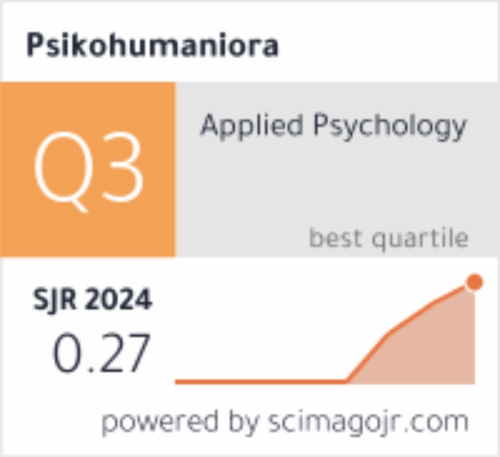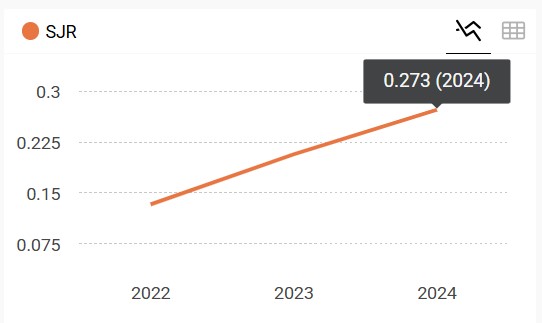Couple resilience predicted marital satisfaction but not well-being and health for married couples in Bali, Indonesia
DOI:
https://doi.org/10.21580/pjpp.v6i1.6520Keywords:
couple resilience, marriage, resilienceAbstract
Married couples face various challenges in their married life, with divorce being one of the threats to their relationship. Spouse resilience is the process by which couples manage marital challenges through positive relationship behavior. This study examines the resilience of partners by including negative behavior in the relationships and examines the effects of interactions between partners. Three hundred couples living in Bali, Indonesia (length of marriage of between 1-10 years) participated by reporting positive and negative behaviors, and the outcomes of their relationship (marital satisfaction, emotional well-being, and general health status). The measurement instruments employed were the Couple Resilience Inventory, Satisfaction with Married Life Scale, and the 36-item Short-Form Health Survey. Model fit analysis showed that behavior in relationships did not predict the outcomes referred to above, and that there was no interaction effect between partners. However, positive behavior showed a higher probability of predicting marital satisfaction, especially for wives (β = .271; β = .403; p < .001). The implications of these findings provide practical suggestions for future partner resilience research to apply a longitudinal approach that repeatedly measures the outcomes of resilience.Downloads
References
Anderson, L. (2019). Rethinking resilience theory in African American families: Fostering positive adaptations and transformative social justice. Journal of Family and Theory Review, 11, 385-397. https://doi.org/10.1111/jftr.12343
Aydogan, D., & Kizildag, S. (2017). Examination of relational resilience with couple burnout and spousal support in families with a disabled child. The Family Journal, 25(4), 407-413. https://doi.org/10.1177/1066480717731215
Beam, C. R., Marcus, K., Turkheimer, E., & Emery, R. E. (2018). Gender differences in the structure of marital quality. Behavior Genetics, 48(3), 209-223. https://doi.org/10.1007/s10519-018-9892-4
Becker, T. E., & Ferry, D. L. (2016). Profiles as a way of learning more about resilience. Industrial and Organizational Psychology: Perspectives on Science and Practice, 9, 503-508. https://doi.org/10.1017/iop.2016.47
Bodenmann, G., Pihet, S., & Kayser, K. (2006). The relationship between dyadic coping and marital quality: A 2-year longitudinal study. Journal of Family Psychology, 20, 485-493. http://dx.doi.org/10.1037/0893-3200.20.3.485
Bonanno, G. A. (2005). Resilience in the face of potential trauma. Current Directions in Psychological Science, 14(3), 135-138. https://doi.org/10.1111/j.0963-7214.2005.00347.x
Bonanno, G. A., Westphal, M., & Mancini, A. D. (2011). Resilience to loss and potential trauma. Annual Review of Clinical Psychology, 7, 511-535. https://doi.org/10.1146/annurev-clinpsy-032210-104526
Bottolfs, M., Støa, E. M., Reinboth, M. S., Svendsen, M. V., Schmidt, S. K., Oellingrath, I. M., & Bratland-Sanda, S. (2020). Resilience and lifestyle-related factors as predictors for health-related quality of life among early adolescents: a cross-sectional study. Journal of International Medical Research. https://doi.org/10.1177/0300060520903656
Bradley, J. M., & Hojjat, M. (2017). A model of resilience and marital satisfaction. The Journal of Social Psychology, 157(5), 588-601. https://doi.org/10.1080/00224545.2016.1254592
Breitenstein, C. J., Milek, A., Nussbeck, F. W., Davila, J., & Bodenmann, G. (2018). Stress, dyadic coping, and relationship satisfaction in late adolescent couples. Journal of Social and Personal Relationships, 35(5), 770-790. https://doi.org/10.1177/0265407517698049
Britt, T. W., Shen, W., Sinclair, R. R., Grossman, M. R., & Klieger, D. M. (2016). How much do we really know about employee resilience? Industrial and Organizational Psychology: Perspectives on Science and Practice, 9(2), 378–404. https://doi.org/10.1017/iop.2015.107
Connor, K. M., & Davidson, J. R. (2003). Development of a new resilience scale: The Connor-Davidson Resilience Scale (CD-RISC). Depression and Anxiety, 18, 76-82. https://doi.org/10.1002/(ISSN)1520-6394
Conradi, H. J., Noordhof, A., Dingemanse, P., Barelds, D. P., & Kamphuis, J. H. (2017). Actor and partner effects of attachment on relationship satisfaction and sexual satisfaction across the genders: An APIM approach. Journal of Marital and Family Therapy, 43, 700-716. https://doi.org/10.1111/jmft.12222
Cosco, T. D., Kaushal, A., Hardy, R., Richards, M., Kuh, D., & Stafford, M. (2015). Operationalising resilience in longitudinal studies: A systematic review of methodological approaches. Journal of Epidemiology & Community Health, 71, 98-104.
Dhana, K. (2018, January 20). Identify, describe, plot, and remove the outliers from the dataset. Retrieved September 14, 2020, from https://datascienceplus.com/identify-describe-plot-and-removing-the-outliers-from-the-dataset/
Diener, E., Emmons, R. A., Larsen, R. J., & Griffin, S. (1985). The Satisfaction With Life Scale. Journal of Personality Assessments, 49(1), 71-75.
Erol, R. Y., & Orth, U. (2014). Development of self-esteem and relationship satisfaction in couples: Two longitudinal studies. Developmental Psychology, 50(9), 2291-2303. https://doi.org/10.1037/a0037370
Fleming, J., & Ledogar, R. J. (2008). Resilience, an evolving concept: A review of literature relevant to Aboriginal research. Pimatisiwin, 6(2), 7-23.
Foster, K. (2020). Resilience in the face of adversity: A shared responsibility. International Journal of Mental Health Nursing, 29, 3-4. https://doi.org/10.1111/inm.12688
Foster, K., Shochet, I., Wurfl, A., Roche, M., Maybery, D., Shakespeare‐Finch, J., & Furness, T. (2018). On PAR: A feasibility study of the Promoting Adult Resilience programme with mental health nurses. International Journal of Mental Health Nursing, 27(5), 1470-1480. https://doi.org/10.1111/inm.12447
Franken, K., Lamers, S., Ten Klooster, P. M., Bohlmeijer, E. T., & Westerhof, G. J. (2018). Validation of the Mental Health Continuum-Short Form and the dual continua model of well-being and psychopathology in an adult mental health setting. Journal of Clinical Psychology, 74(12), 2187-2202. https://dx.doi.org/10.1002%2Fjclp.22659
Hawkins, A. J., Wiloughby, B. J., & Doherty, W. J. (2012). Reasons for divorce and openness to marital reconciliation. Journal of Divorce & Remarriage, 53(6), 453-463. https://doi.org/10.1080/10502556.2012.682898
Heffer, T., & Willoughby, T. (2017). A count of coping strategies: A longitudinal study investigating an alternative method to understanding coping and adjustment. PLOS ONE, 12(10), e0186057. https://doi.org/10.1371/journal.pone.0186057
Hu, L., & Bentler, P. M. (1999). Cutoff criteria for fit indexes in covariance structure analysis: Conventional criteria versus new alternatives. Structural Equation Modeling: A Multidisciplinary Journal, 6(1), 1-55. https://doi.org/10.1080/10705519909540118
Jackson, J., Miller, R., Oka, M., & Henry, R. (2014). Gender differences in marital satisfaction: A meta‐analysis. Journal of Marriage and Family, 76, 105-129. https://doi.org/10.1111/jomf.12077
Jayani, D. H. (2020, February 20). Ramai RUU Ketahanan Keluarga, berapa angka perceraian di Indonesia? Retrieved September 19, 2020, from https://databoks.katadata.co.id/datapublish/2020/02/20/ramai-ruu-ketahanan-keluarga-berapa-angka-perceraian-di-indonesia
Johnson, H. A., Zabriskie, R. B., & Hill, B. (2006). The contribution of couple leisure involvement, leisure time, and leisure satisfaction to marital satisfaction. Marriage & Family Review, 40(1), 69-91. https://doi.org/10.1300/J002v40n01_05
Keyes, C. L. (2002). The mental health continuum: From languishing to flourishing in life. Journal of Health and Social Behavior, 43(2), 207-222. https://doi.org/10.2307/3090197
Lins, L., & Carvalho, F. M. (2016). SF-36 total score as a single measure of health-related quality of life: Scoping review. SAGE open medicine, 4, 2050312116671725. https://doi.org/10.1177/2050312116671725
Lock, S., Rees, C., & Heritage, B. (2020). Development and validation of a brief measure of psychological resilience: The state-trait assessment of resilience scale. Australian Psychologist, 55, 10-25. https://doi.org/10.1111/ap.12434
Lucas, R. E., & Dyrenforth, P. S. (2006). Does the existence of social relationships matter for subjective well-being? In R. E. Lucas, P. S. Dyrenforth, K. D. Vohs, & E. J. Finkle (Eds.), Self and relationships: Connecting intrapersonal and interpersonal processes (pp. 245-273). New York, NY: Guilford Press.
Luthar, S. S., & Cicchetti, D. (2000). The construct of resilience: Implications for interventions and social policies. Development and Psychopathology, 12(4), 857-885. https://doi.org/10.1017/s0954579400004156
Luthar, S. S., Cicchetti, D., & Becker, B. (2000). The construct of resilience: a critical evaluation and guidelines for future work. Child Development, 71(3), 543-562. https://doi.org/10.1111/1467-8624.00164
Maltby, J., Day, L., & Hall, S. (2015). Refining trait resilience: Identifying engineering, ecological, and adaptive facets from extant measures of resilience. PLOS ONE, 10(7), e0131826. https://doi.org/10.1371/journal.pone.0131826
Masten, A. S. (2014). Global perspectives on resilience in children and youth. Child Development, 85(1), 6-20. https://doi.org/10.1111/cdev.12205
Masten, A. S., & Barnes, A. J. (2018). Resilience in children: Developmental perspectives. Children (Basel, Switzerland), 5(7), 98. https://doi.org/10.3390/children5070098
Maulana, H., Khawaja, N., & Obst, P. (2019). Development and validation of the Indonesian Well‐being Scale. Asian Journal of Social Psychology, 22, 268-280. https://doi.org/10.1111/ajsp.12366
Medvedev, O. N., & Landhuis, C. E. (2018). Exploring constructs of well-being, happiness and quality of life. PeerJ, 6, e4903. https://doi.org/10.7717/peerj.4903
Meltzer, A. L., & McNulty, J. K. (2010). Body image and marital satisfaction: evidence for the mediating role of sexual frequency and sexual satisfaction. Journal of Family Psychology, 24(2), 156-164. https://doi.org/10.1037/a0019063
Mustofa, A. (2020, August 6). Aduh! Kasus perceraian di Buleleng meningkat saat wabah corona. Retrieved September 19, 2020, from https://radarbali.jawapos.com/read/2020/08/05/207578/aduh-kasus-perceraian-di-buleleng-meningkat-saat-wabah-corona
Nath, P., & Pradhan, R. K. (2012). Influence of positive affect on physical health and psychological well-being: Examining the mediating role of psychological resilience. Journal of Health Management, 14(2), 161-174. https://doi.org/10.1177/097206341201400206
Novitasari, L., Perwitasari, D., & Khoirunisa, S. (2016). Validity of short-form 36 (SF-36) Indonesian version on rheumatoid arthritis patients. Jurnal Kedokteran dan Kesehatan Indonesia, 7(3), 80-86. https://doi.org/10.20885/JKKI.Vol7.Iss3.art2
Peláez-Ballestas, I., Boonen, A., Vázquez-Mellado, J., Reyes-Lagunes, I., Hernández-Garduño, A., Goycochea, M. V., . . . Burgos-Vargas, R. (2015). Coping Strategies for Health and Daily-life stressors in patients with rheumatoid arthritis, ankylosing spondylitis, and gout. Medicine, 94(10), e600. https://doi.org/10.1097/MD.0000000000000600
Phillips, N. (2015, September 8). Maximum-Likelihood Fitting in R. Retrieved October 1, 2020, from http://rstudio-pubs-static.s3.amazonaws.com/107801_2785d7d7a49744539ef21eaaebe4fe5a.html
Rafnsson, F. D., Jonsson, F. H., & Windle, M. (2006). Coping strategies, stressful life events, problem behaviors, and depressed affect. Anxiety, Stress & Coping, 19(3), 241-257. https://doi.org/10.1080/10615800600679111
Rostami, A., Ghazinour, M., Nygren, L., Nojumi, M., & Richter, J. (2013). Health-related quality of life, marital satisfaction, and social support in medical staff in Iran. Applied Research in Quality of Life, 8, 385-402. https://doi.org/10.1007/s11482-012-9190-x
Salsman, J. M., Victorson, D., Choi, S. W., Peterman, A. H., Heinemann, A. W., Nowinski, C., & Cella, D. (2013). Development and validation of the positive affect and well-being scale for the neurology quality of life (Neuro-QOL) measurement system. Quality of life research: An international journal of quality of life aspects of treatment, care and rehabilitation, 22(9), 2569-2580. https://doi.org/10.1007/s11136-013-0382-0
Sanford, K., Backer-Fulghum, L. M., & Carson, C. (2016). Couple resilience inventory: two dimensions of naturally occurring relationship behavior during stressful life events. Psychological Assessment, 28(10), 1243-1254. https://doi.org/10.1037/pas0000256
Schmitt, M., Kliegel, M., & Shapiro, A. (2007). Marital interaction in middle and old age: A predictor of marital satisfaction? International Journal of Aging & Human Development, 65(4), 283-300. https://doi.org/10.2190/AG.65.4.a
Schweizer, V. J. (2020). Divorce: More than a century of change, 1900-2018. Family Profiles, FP-20-22. https://doi.org/10.25035/ncfmr/fp-20-22
Surijah, E. A., & Prakasa, D. Y. (2020). Kepuasan pernikahan dan bias harapan sosial. Jurnal Ilmiah Psikologi MIND SET, 11(01), 14-25. https://doi.org/10.35814/mindset.v11i01.1269
Ünal, Ö., & Akgün, S. (2020). Conflict resolution styles as predictors of marital adjustment and marital satisfaction: An actor–partner interdependence model. Journal of Family Studies. 10.1080/13229400.2020.1766542
Ungar, M. (2008). Resilience across cultures. The British Journal of Social Work, 38(2), 218-235. https://doi.org/10.1093/bjsw/bcl343
Ware, J. J., & Sherbourne, C. (1992). The MOS 36-Item Short-Form Health Survey (SF-36): I. Conceptual framework and item selection. Medical Care, 30, 473-483.
Willoughby, B. J., Yorgason, J., James, S., & Kramer Holmes, E. (2020). What does marriage mean to us? Marital centrality among newlywed couples. Journal of Family Issues. https://doi.org/10.1177/0192513X20949905
Zautra, A., Hall, J., & Murray, K. (2010). Resilience: A new definition of health for people and communities. In A. Zautra, J. Hall, K. Murray, J. Reich, A. Zautra, & J. Hall (Eds.), Handbook of Adult Resilience (pp. 3-30). New York: Guilford.
Downloads
Published
How to Cite
Issue
Section
License
The copyright of the accepted article shall be assigned to the publisher of the journal. The intended copyright includes the right to publish the article in various forms (including reprints). The journal maintains the publishing rights to published articles.
In line with the license, authors and any users (readers and other researchers) are allowed to share and adapt the material only for non-commercial purposes. In addition, the material must be given appropriate credit, provided with a link to the license, and indicated if changes were made. If authors remix, transform, or build upon the material, authors must distribute their contributions under the same license as the original.



